Natural Products Expo West – Photo Gallery
Thought it might be fun to take a look at some of the cool exhibits, enthusiastic people and tasty products from Natural Products Expo West:
Thought it might be fun to take a look at some of the cool exhibits, enthusiastic people and tasty products from Natural Products Expo West:
List-making! In this episode of the TradeshowGuy Monday Morning Coffee, I take a look at the top 7 things I like about being a tradeshow exhibit project manager and owner of TradeshowGuy Exhibits. And I explain why making a checklist for your exhibit project is a very good thing.
As for today’s One Good Thing, I shared a night sky app called SkyView. Check it out.
Check out the Monday, February 13, 2017 edition of the TradeshowGuy Monday Morning Coffee, where I go over organization, accountability and structure. And a short list from Richard Larsen of Brandwatch: Ten Top Tips for a Successful Tradeshow Booth.
The One Good Thing I referenced in the vlog was night skiing, in particular at Hoodoo Ski Bowl in the Central Oregon Cascades. Lovely!
There are hundreds of styles and types of exhibits at tradeshows, but in my estimation you can reduce them to just a handful of ‘kinds’ of exhibits. Do you recognize these?
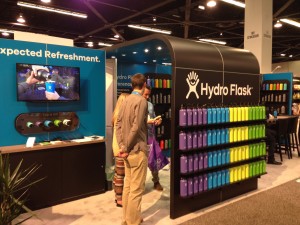
Large Format Well-Branded Exhibit. Most likely an island, but you can tell in an instant who the exhibitor is. Highly professional. The staff is smiling, greeting everyone appropriately. Kicking ass and taking names.
Next time you walk the show floor, see how many of each kind of exhibits you can identify! And if you can add to our list, feel free to drop a comment!
Hey, it’s time to do another wrap up of tradeshow exhibit design and promotion ideas. Let’s take a swing around the internet, shall we?
First, we stop at FitSmallBusiness.com for a look at over two dozen design and promotion ideas. One idea I really like is to walk the show floor prior to the doors opening to the public and introducing yourself and inviting other exhibitors to come by your booth for a freebie.
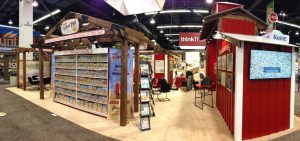
From the Tradeshow Advisor comes a look at how to use all the display elements at your disposal to attract eyeballs. Using lighting, motion, sound and smell, you can get attendees senses involved.
Pinnacle Displays offers the 10 commandments for designing effective tradeshow graphics.
Northwest Creative Imaging posted a great infographic that details the best practices for tradeshow booth design. It’s a good one.
Our old friends at Handshake.com offer several booth design ideas to help you stand out at tradeshows.
And finally, let’s swing by Envision Creative Group for 5 Elements of an Awesome Booth Design.
All in all, some good company to keep and excellent ideas to ponder and incorporate!
There are three phases to getting people to talk about your tradeshow exhibit. First, you’d love to get them talking about it before the show. Second, you want them talking about the exhibit during the show. And finally, you want to make it memorable enough so that they’re talking about it after the show.
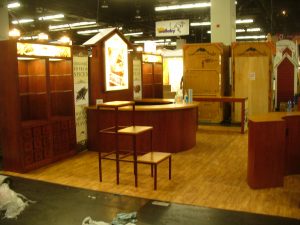
Realistically, I suppose it’s hard to achieve all of those bits and pieces with every exhibit and every show, but as my old football coach used to say, “It don’t hurt to try, do it?”
Prior to the show, set some goals. Figure out what you’d like to accomplish at the show in terms of booth traffic, leads generated and sales generated. Having these numbers in hand will help you focus. Drive traffic to your booth starting a week or so prior to the show by teasing products or in-person appearances in your booth on Facebook, Instagram, Twitter and LinkedIn, making sure you use the standard show hashtag. If you do a pre-show mailing, you can increase your booth traffic by increasing a promotional product in that mailing.
During the show, the best way to get people to talk about your exhibit is to have all hands on deck. Your staff should be well-trained and well-prepared for the show. They should be dressed appropriately (uniforms, matching tees?). The electronics in the booth should be tested and working properly, graphics should be attractive and functional. On social media, send out time-sensitive tweets and posts that invite people to see something new or meet somebody, or interact with something in the booth that appeals to the five senses. If you can pull off a few of these ideas in a clever and memorable way, show attendees will go out of their way to mention your booth.
After the show, follow up with all leads generated in a timely manner. Post photos of your exhibit and visitors over the next few weeks on social media. Mention any press you many have gotten online or in a newsletter. If you’ve created a list of email addresses or phone numbers of booth visitors, reach back to them to ask their opinion.
Word of mouth is an effective way to market your business. And even though you’re at a tradeshow, getting people to talk about your exhibit and presence at the show can start prior to the show and linger afterwards!
Tradeshow Infographics, like any infographic, serve a very useful purpose. They give you a way to visually digest information that might otherwise be a little more difficult to grasp or understand. But an infographic, if done well, gives a reader a quick look as well as a chance to dig deeper into a topic.
With that said, we ran across three tradeshow infographics that illuminate areas of tradeshow marketing that anyone in the industry can easily use. Let’s stack them up.
The first comes courtesy the Northwest Creative Imaging Blog, with best practices for tradeshow booth design. Maybe more directed at the folks who actually design and assemble the booth, but certainly any tradeshow manager in charge of a new booth can appreciate the ideas contained here.

Up next is a look at 6 Things to Do Before Your Next Tradeshow, thanks to Discover Infographics:

And finally, from marketing expert and blogmaster Brandon Gaille, we look at Tradeshow Booth Etiquette:

Secrets to tradeshow success? There’s no secret! It’s all out in the open. Actually, it’s all lurking online somewhere. Just for fun, I plugged the search term “tradeshow success secrets” into the Google to see what I came up with.
Everyone seemed to want to chime in: Huffington Post, Inc., Brandwatch, Forbes, Tradeshow Advisor, USA Today and others.
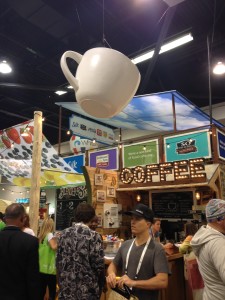
Let people play with things. Yes, adults like to get hands-on experience as much as kids do. Create an experience where visitors can interact with something and they’ll stick to your booth longer than others.
I get this question frequently in its many forms: how much should a tradeshow exhibit cost? How much can I expect to pay for a new tradeshow exhibit? What is the price range for a new tradeshow exhibit?
While there is no set answer, as the price range can be YUUUge for similar exhibits, there are industry averages. Those industry averages adjust slightly from year to year, but to me a good rule of thumb is to assign about $1,000 to $1,500 a linear foot for inline booths and in the case of custom islands, figure the average square foot cost to be in the neighborhood of $135 – $160. In most cases these will be true, but certainly those numbers can be affected by adding a lot of electronics or custom items.
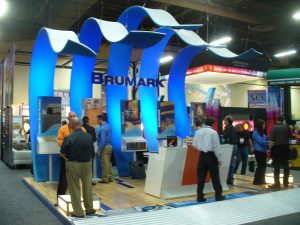
But you can also approach it from other directions. Such as: how much can you realistically spend? What are your expectations for your booth? How do you want your exhibit to compare to your fellow exhibitors, and especially, how do you want to be judged against your direct competitors? Knowing your budget and the limitations from that budget are important. However, I’ve seen creative marketing people manage to figure out how to squeeze every last drop out of a marketing dollar to make it go further than what you might do at your average tradeshow exhibit house. Backwalls made of old barn wood, pallets or bicycle frames, anyone? I’ve seen ‘em, and they can look good and function well.
Some of the tradeoffs involved with spending those marketing dollars on tradeshow exhibits mean that while you might come up with a very economical homestyle booth, it might take you a lot longer to set up and dismantle, and it might have to be trashed after a time or three at the show. And it might ship in odd shaped containers or on pallets. Creativity comes in all forms, but in the end it still has to conform to the realities of the world of shipping, and the ease of setting up and dismantling, and the size of your assigned booth space.
Often a company will be faced with competitors that are dominating the show in terms of size of booth and in-booth activity, which leads to more show floor sizzle and buzz. So the question becomes one of whether you have the financial ability to compete at that level.
Another way to look at the puzzle is to know that you don’t have the budget to scale the mountain like those other competitors, but you do have something else: a creative marketing group that knows how to stand out in a crowd.
It’s another way of saying that yes, industry averages are a good starting point to know what things cost that end up on the tradeshow floor, and yes, you can hack your way into a cheaper booth, but what is your net result? Regardless of what the booth costs or looks like or how much or little you spent, you still have to live in it for days at a time, and you still have to invite attendees in and pitch them on your products or services. And the more conducive your exhibit is to those parallel goals, the higher your chances of success.
While having a great exhibit is certainly important, it’s not everything.
Knowing how to attract a crowd is important, but it’s not the everything, either.
Knowing what to DO with the crowd once they arrive – now that’s your meal ticket!
Tradeshow record keeping. Yikes! Who wants to keep track of everything.
Record keeping is one of those things that most of us wish we didn’t have to do, – we know it’s tedious – but know we really should do. So how much should we keep, what should we keep, where is the best place to keep it, and WHY?
Tim Patterson discusses tradeshow record keeping in this brief but informative webinar: